In the USA, whenever I saw a Muslim woman wearing a headscarf, (Hijab) but also with a tight hugging top and casual jeans, I would usually stop and ask her why she dresses in this way.
The answers I received were very different than those to the same question I posited to more religious Muslim women who were fully clothed in an Islamic cloak (Abaya), long headscarf (Khimar), and face-veil (Niqab).
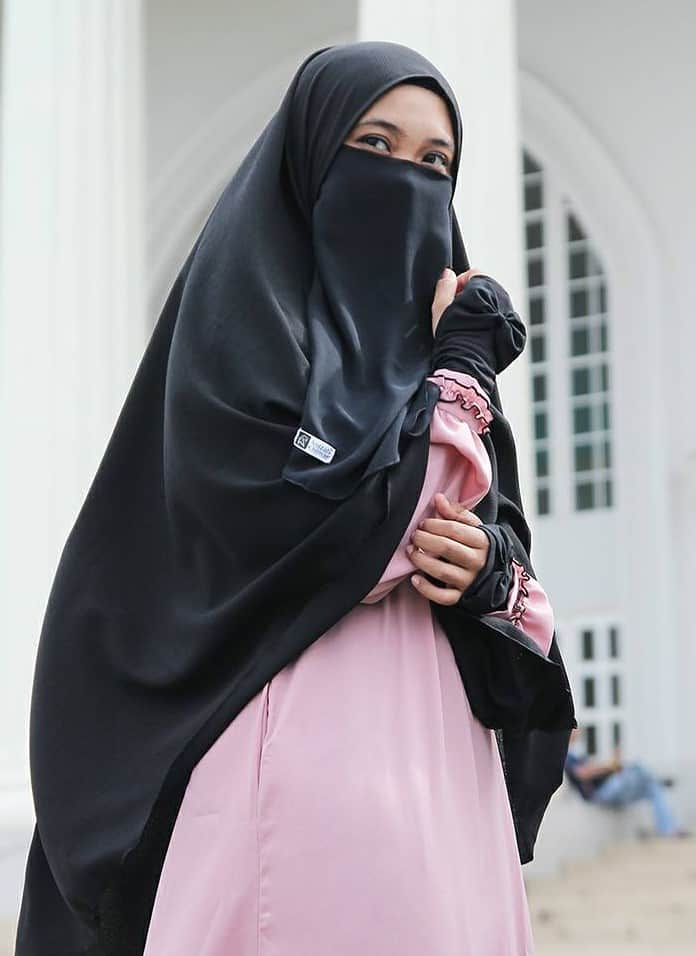
It seems that so many Muslim women wear the Islamic headscarf Hijab for a variety of personal and religious reasons.
So, to get clear on the issue, I decided to do some more research to find out exactly why.
So, Why Do Muslim Women Wear Headscarfs (Hijab حجاب )?
In the Quran, Allah (SWT) orders Muslim women to cover the entire body -their heads, torsos, legs, and to hide their beauty and adornments in the presence of males who are not immediate family members. (Quran 24:31 ). This injunction is based on the concept of Awrah or intimate body parts that in Islam are considered sinful to reveal. For women, the Awrah refers to her entire body except for her face, hands, and feet.
). This injunction is based on the concept of Awrah or intimate body parts that in Islam are considered sinful to reveal. For women, the Awrah refers to her entire body except for her face, hands, and feet.
Sadly many Muslim women are ignorant of this ruling and claim that they wear the headscarf (Hijab) out of personal choice only, or for cultural reasons, for the family, even because of tradition.
In reality, in the presence of strange men whilst out in public, Islam requires women to dress modestly and to properly cover the head, breasts, and genitals area (Hijab) in very specific ways.
Why Is A Woman’s Body Considered ‘Awrah’ And Necessary To Cover?
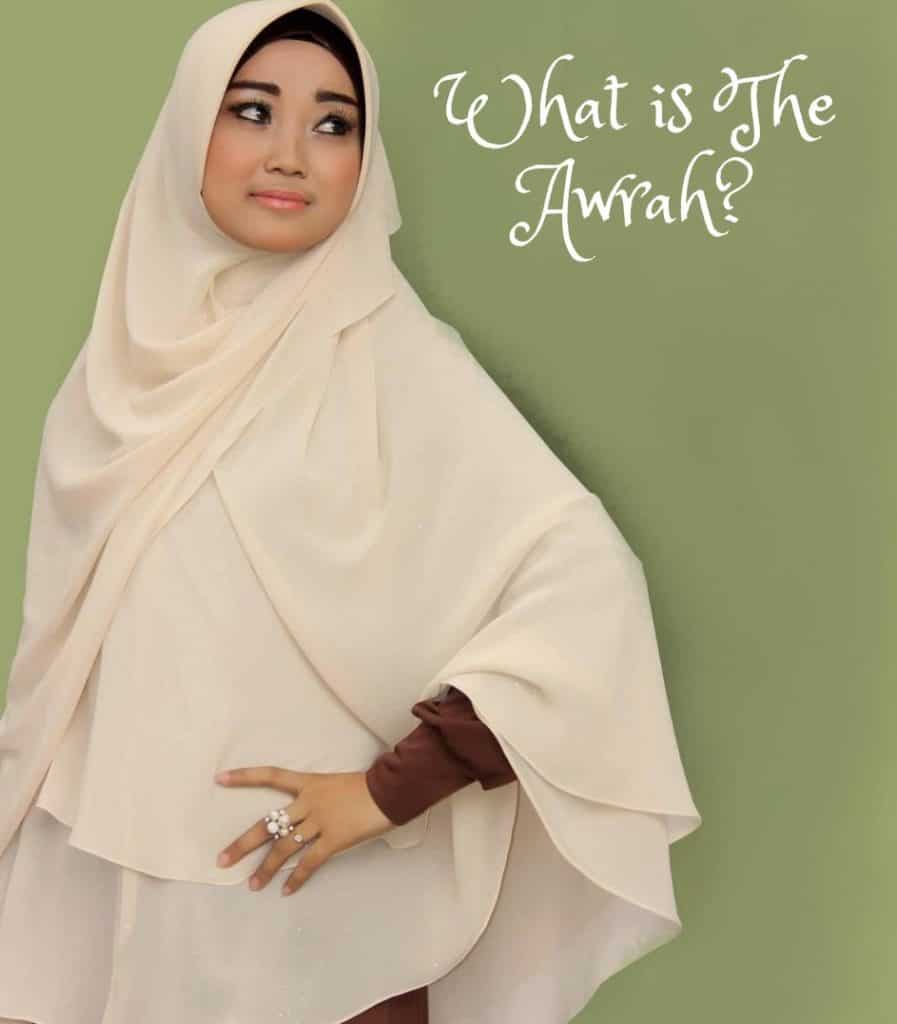
Of course, the reason is obvious. Normally, the sight and contours of the female form excite men. The feelings are natural biological responses related to sex and desire for procreation with women.
In ordering Muslim women to cover sufficiently, (Quran 24:31 ), Allah (SWT) ensures that desires in men’s hearts do not become unnecessarily inflamed and that in an Islamic society women remain respected and protected.
), Allah (SWT) ensures that desires in men’s hearts do not become unnecessarily inflamed and that in an Islamic society women remain respected and protected.
Female Modesty
Except for nudist beaches and the like, today most women across the world would never dream of casually exposing their breasts and genital areas in public.
Out of natural shyness and modesty, it is still normal for women, Muslims or otherwise, to keep these parts of the body private and out of sight.
This was especially true for centuries in the past. Women would make sure that all parts of her body were fully covered from the head down to the feet.
Clothes and fashion were intended to enhance her beauty, show her class, and express her personality not to sexualize her and provide windows for exposing herself.
It is only in relatively recent times that partial nudity and women openly exposing her body parts have become increasingly more commonplace.
Islamic Modesty
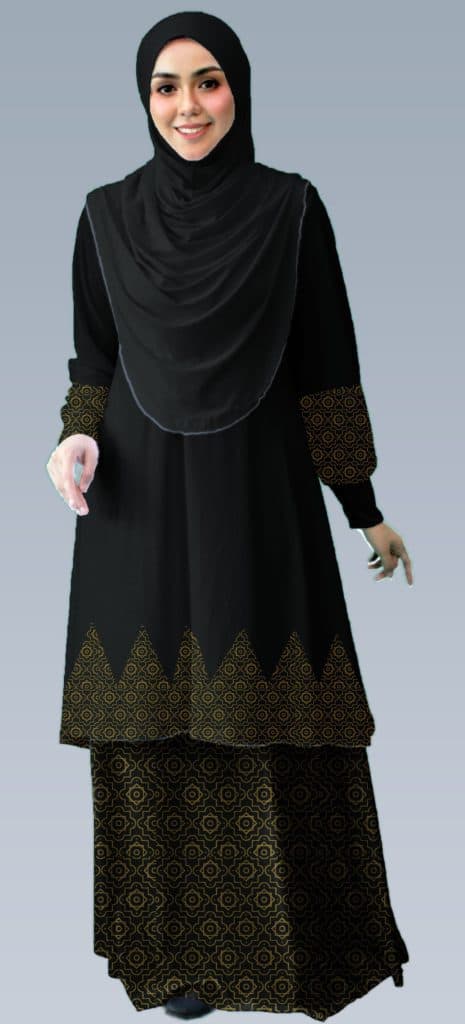

In Islam, female modesty is regarded the same today as it always was in the past. It has remained unchanged since the time the Quran was revealed.
It has always included the covering of women’s hair and the wearing of clothes that sufficiently hide the body and with material wide enough so as not to reveal the physical outline and the shape of the breasts and genitals.
For many Muslims too, it may also include the face.
Modesty Also Includes Speech
Modesty for Muslim women also includes speech. In the Quran, (Al-Ahzab 33:32 ) women are exhorted NOT to speak softly to strange men.
) women are exhorted NOT to speak softly to strange men.
Soft, sweet female speech can awaken men’s hearts.
The fact that the above verse was intended for the wives of Prophet Mohammed (SAW) is generally understood to include all Muslim women then as today.
So both the female body and her speech can stimulate men’s sexual interests and raise their passions.
As protection from unwanted attention and sexual advances, Muslim women are expected to sufficiently cover, i.e. to observe Hijab, and to avoid overly tender forms of speech.
So, How, According To Islam, Should Muslim Women Dress?
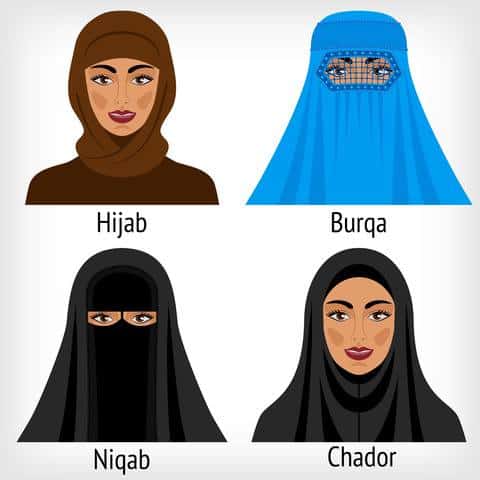
Most people think that Hijab حجاب only means a headscarf. However, in Arabic, the word Hijab is understood as a screen, a kind of partition that suggests separation (usually of the sexes) and by implication providing protection.
So, indeed the headscarf is clearly to be understood as Hijab حجاب something worn on the head and upper body and as protection from the provocation of desires and sexual attention from men.
Example Of Hijab حجاب In The Quran
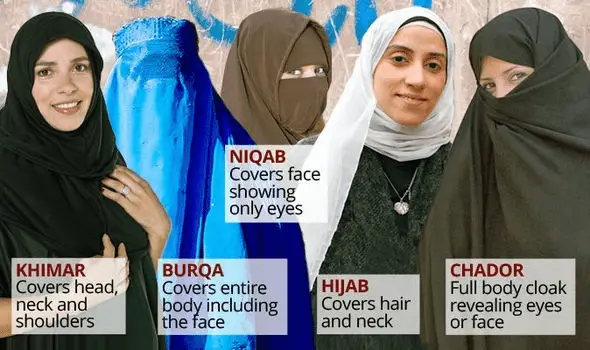
The order to create a Hijab between the sexes is given by Allah (SWT) in the Quran Al- Ahzab 33:53 .
.
In this verse, Allah (SWT) commands men use a screen or partition (Hijab) when talking to the wives of Prophet Mohammed (SAW).
‘And when you ask [his wives] for something, ask them from behind a partition. حجاب (That is purer for your hearts and their hearts)’
Al Ahzab 33:53
The Muslim Woman’s Dress Code
In the privacy of her own homes and amongst immediate male family members, i.e. grandfather, father, brother, son, uncle, nephew, Muslim women do not need to observe any special kind of dress code.
However, in front of men who are not immediate family members, Muslim women are expected to lower their gazes, guard their modesty and to draw a cover (Khimar) over their chests and hide their beauty. (Quran An-Nur 24:31 ).
).
In terms of clothing, this injunction takes its expression in the typical form of Islamic female dress that are wide fitting cloaks, coats (Abayas), long flowing head scarfs (Khimars), head coverings (Hijabs) and face veils (Niqaabs).
In Islamic countries, each has a different name and style but they all function the same to sufficiently hide women’s physical form and to protect her from unwelcome male attention.
Non-Muslims Misunderstand The Concept of Hijab
The Hijab is Oppressive
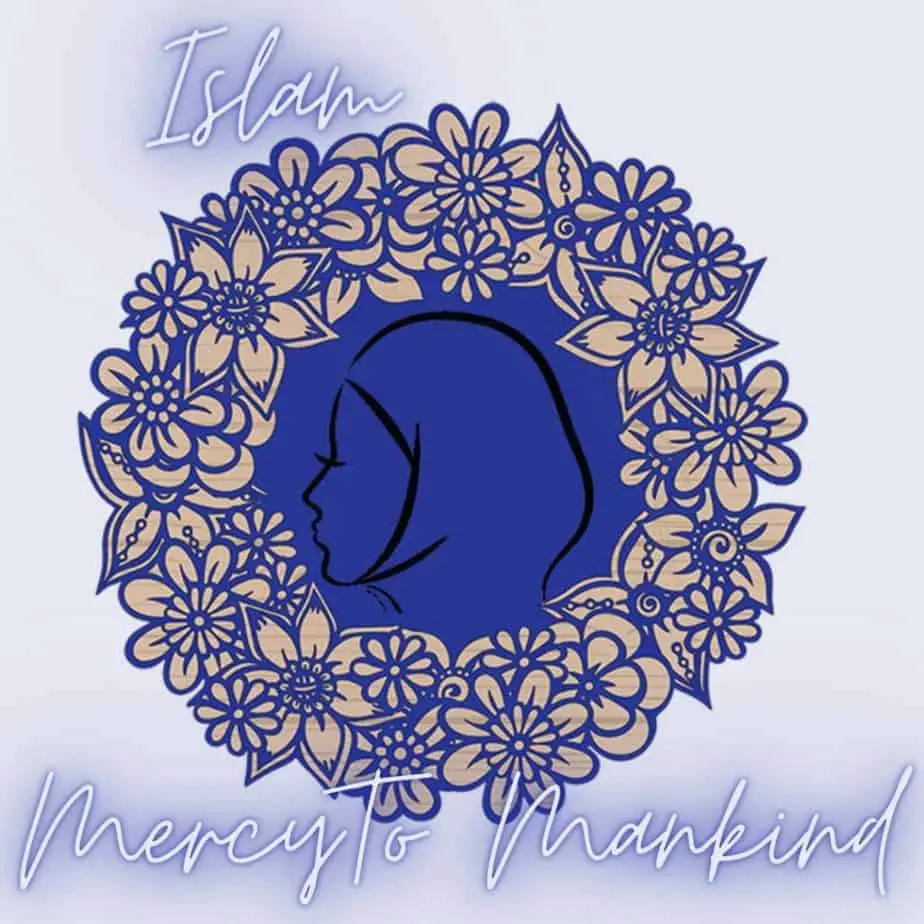
The headscarf (Hijab) is often controversial in non-Muslim societies. People in these countries regard it as oppressive to women and suggest that Muslim women are being forced against their wills by fathers and husbands to wear headscarves and face veils.
In the modern age of Western-styled feminist liberation, the Islamic head-covering represents an outdated form of submission to men.
Wearing Headscarf (Hijab) Is Dignified and Noble

On the contrary, practicing Muslim women completely reject that they are under pressure to wear a headscarf (Hijab).
They maintain that the choice to put it on is completely their own and that they are not influenced by so-called oppressive male family members.
Female Muslims defend wearing the headscarf (Hijab) as dignified, noble, and as something elevating Muslim women in the eyes of others.
These same women view female Western-styled public dress as incomplete, overly revealing, and heavily sexualized.
Muslim women understand that that the purpose of Islamic covering (Hijab) is to first and foremost an act of submission to the creator Allah (SWT) and are not concerned with the changing whims and notions of other human beings (Allah’s creation).
Note here too that many women who decide to wear the headscarf (Hijab) for the first time often have to struggle in dealing with their reluctant husbands and family members who have a poor understanding of Islam and issues related to female dress.
Men Should Not Look And Touch
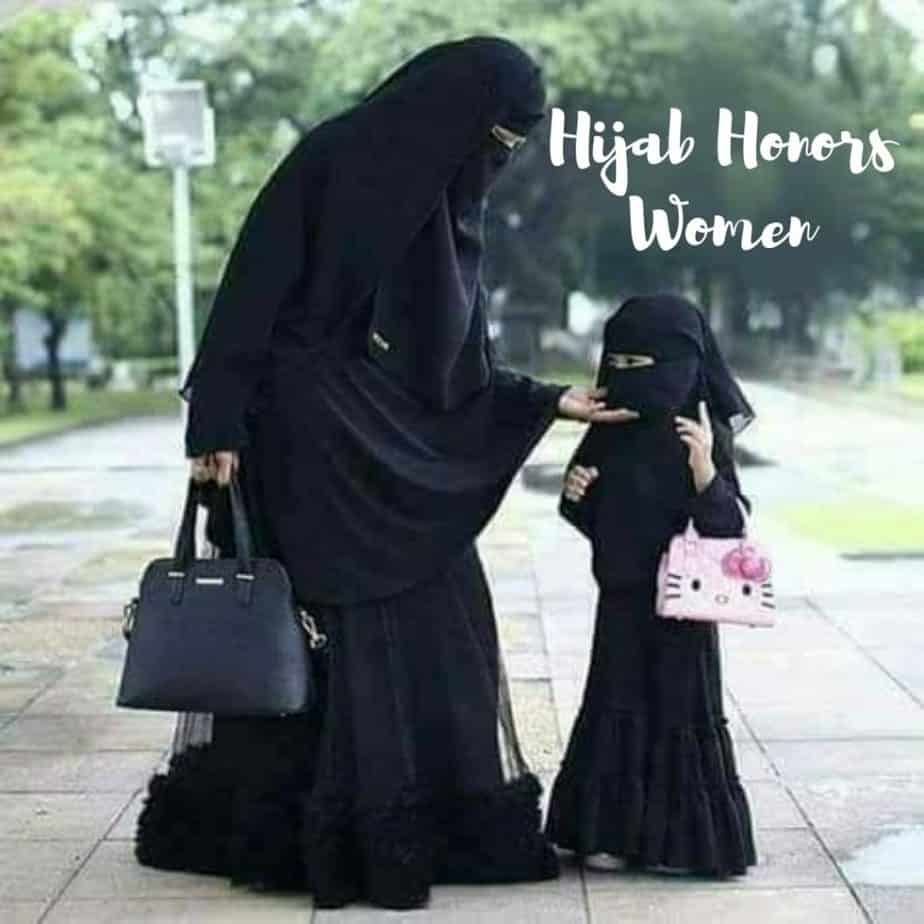
The modern feminist opinion also maintains that women should be free to dress in any way they choose fit and that harassment and sexual attacks on females are solely to be blamed on men and their unbridled passions.
They assert that women should not need to adopt special dress codes just to protect themselves from male attention and sexual assault.
Rather, the burden is on men to behave responsibly irrespective of how a woman dresses.
Such a view ignores the power of the female form to impress men’s hearts and the strength of male sexual responses to it.
The fact is that men are biologically hard-wired with the desire to look at women and feel a deep sexual attraction to women.
Conversely, women wish men to look at them and respond in kind. It is a natural phenomenon and necessary in the procreation of the human species.
Men And Women Are Ordered To Lower Their Gaze
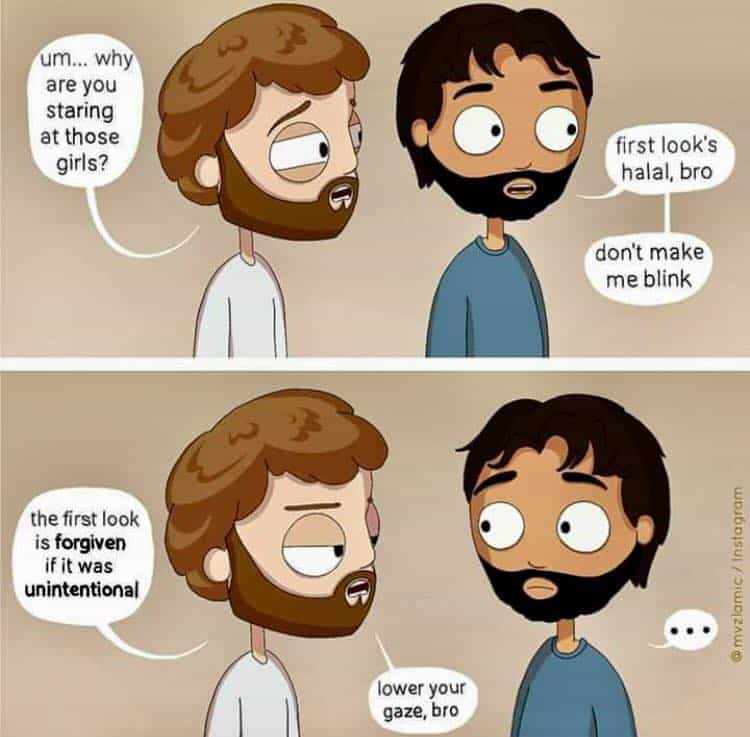

Islam understands that men desire women, but the best way to dampen passions is simply for men not to look at women – full stop.
Allah (SWT) in the Quran commands men to lower their gaze upon encountering a woman who is not related to him. (Quran An-Nur 24:30). Essentially, men should refrain from gazing upon such sinful things.
Tell the believing men to reduce [some] of their vision and guard their private parts. That is purer for them. Indeed, Allah is Acquainted with what they do.
An-Nur 24:30
Likewise, because women like to be viewed and admired, (as discussed previously) they also are admonished to guard their private parts and hide their beauty. (Quran An-Nur 24:31 ).
).
In Islam, women are expected to dress appropriately in the knowledge their bodies do provoke natural sexual responses in men.
Also, it teaches men to restrain themselves at all times by lowering their gaze.
For Muslims, sexual needs are only to be met in the context of marriage. In everyday life, both men and women are taught how to cut off inappropriate sexual distractions by separating themselves and not allowing such feelings to arise in the first place.
Muslims Misunderstand Or Ignore The Concept Of Hijab
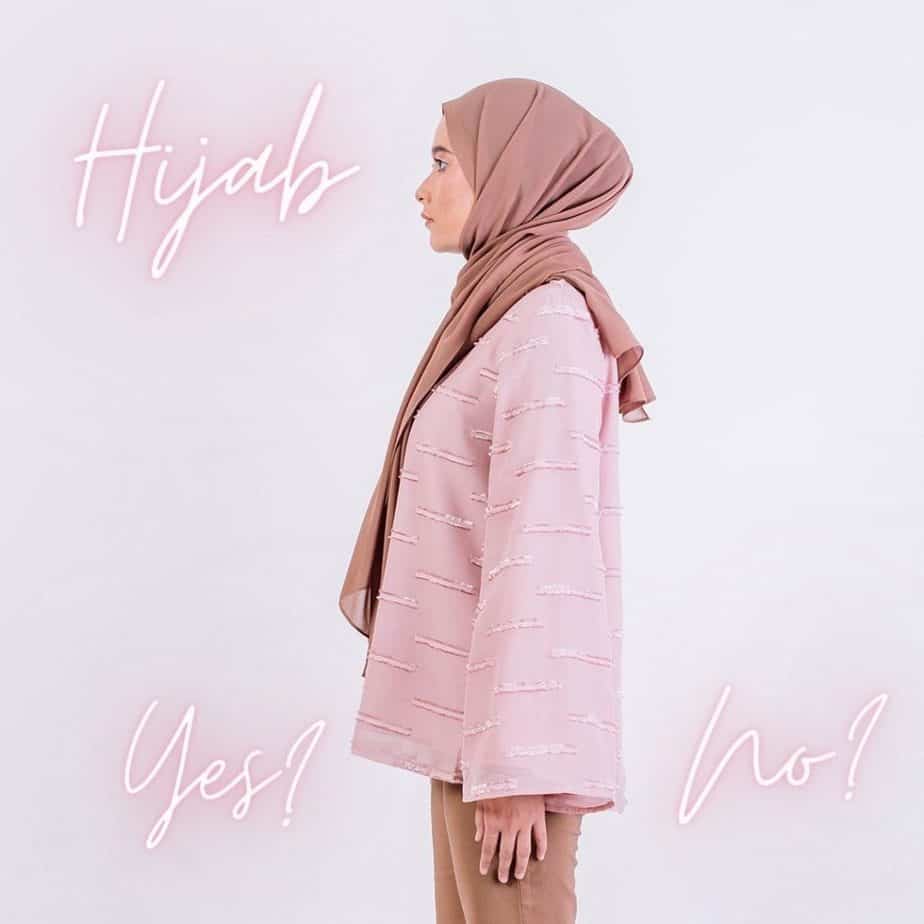
Many Muslims choose to remain ignorant of the Islamic injunctions for women to observe the headscarf (Hijab).
Their understanding of the religion is based purely on unexamined family, cultural or societal beliefs that often conflict with correct Islamic teachings.
They often make the claim that ‘Faith is Found Within Not Without’. The headscarf (Hijab) is simply an outer manifestation of inner faith and for that reason doesn’t need to be displayed.
They also wrongly choose to associate the headscarf (Hijab) with Islamic extremism in that it appears to represent a set of views that are contrary to current political consensus.
The headscarf is also viewed as backward and old fashioned belonging to a past era.
The Headscarf (Hijab) Is Not For The Workplace

Also, putting on a headscarf for work doesn’t suit the modern working environment and that it goes against their ideas of the business culture, class aspirations, modernity, and progress.
This view is especially common in modern Arab and Asian countries. However, there are countless instances of Muslim women choosing to wear headscarves and Islamic clothing at work both in Muslim and non-Muslim countries.
There is no doubt that such women are in any way impeded in the performance of their duties and are perfectly successful in their jobs.
However, the pressure to remove the veil in the workplace still remains a major obstacle to many women wanting to observe the correct dress code at work and is an unnecessary burden.
Whatever the objection to the headscarf (Hijab), in the minds of cultural Muslims, women are free to wear a headscarf (Hijab) or not so long as they dress modestly.
They also reason that not wearing one does not make a woman any less of a Muslim in the eyes of Allah (SWT).
What matters is your inner faith and not your outward appearance.
These objections are easily dismissed when considering the Quranic verses (above) on women covering, men lowering the gaze and the importance of Hijab in the Quran and for Muslims in everyday life.
Face Veil (Niqaab) Is Especially Divisive
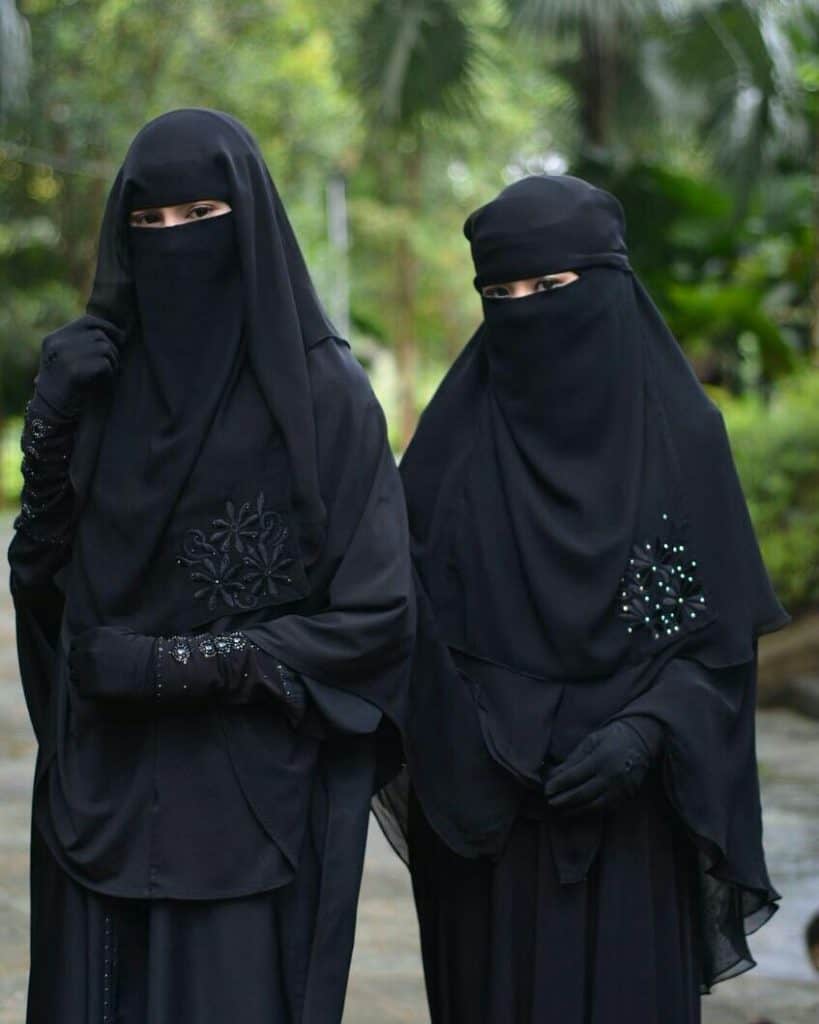
Both Muslims and non-Muslims alike seem to have strong opinions when it comes to wearing the face veil or Islamic Niqaab. It is a hotly debated issue and provokes strong reactions in discussions.
Cultural Muslims argue that because the Niqaab is not mentioned in the Quran, (untrue) then it is only a cultural practice originating in Saudi Arabia and the Gulf and so not relevant to themselves.
They maintain because it is cultural, it has nothing to do with Islam. Given that such Muslims so easily find excuses for not wearing headscarves (Hijab), it is hardly surprising that they find the face veil (Niqaab) so contentious.
Western And Arab Nations Ban The Face Veil
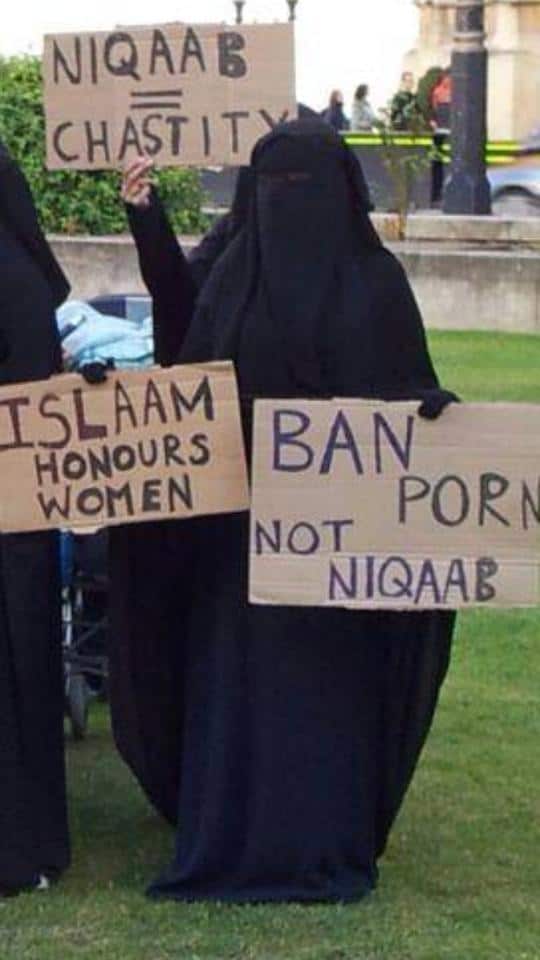
Holland, France, Belgium, Bulgaria, Egypt, Switzerland, Italy, and Chad all have bans or partial bans on the wearing of the Islamic face veil (Niqaab). Women who chose to put it on in these countries can receive heavy fines.
It is unclear what the objections are to it other than the fact that the face is hidden and you cannot see the face of the person you are talking with.
The same objections could be levelled at people who out of necessity wear medical face masks (Coronavirus pandemic) or motorcycle helmets. But they rarely are.
However in the case of Muslim women who chose to wear the Islamic face veil the objections are always raised.
However, in reality, I think opposition to the face-veil (Niqaab) has less to do with not seeing a person’s face since like a facemask it does not impede verbal communication.
The issue is more that it is a sign or a symbol of thea# religion of Islam that dictatorships and insecure democratic regimes fear and abhor the most since it appears to represent a credible challenge to the current political status quo.
Is The Face Veil Considered To Be An Obligatory Islamic Headcover (Hijab)?
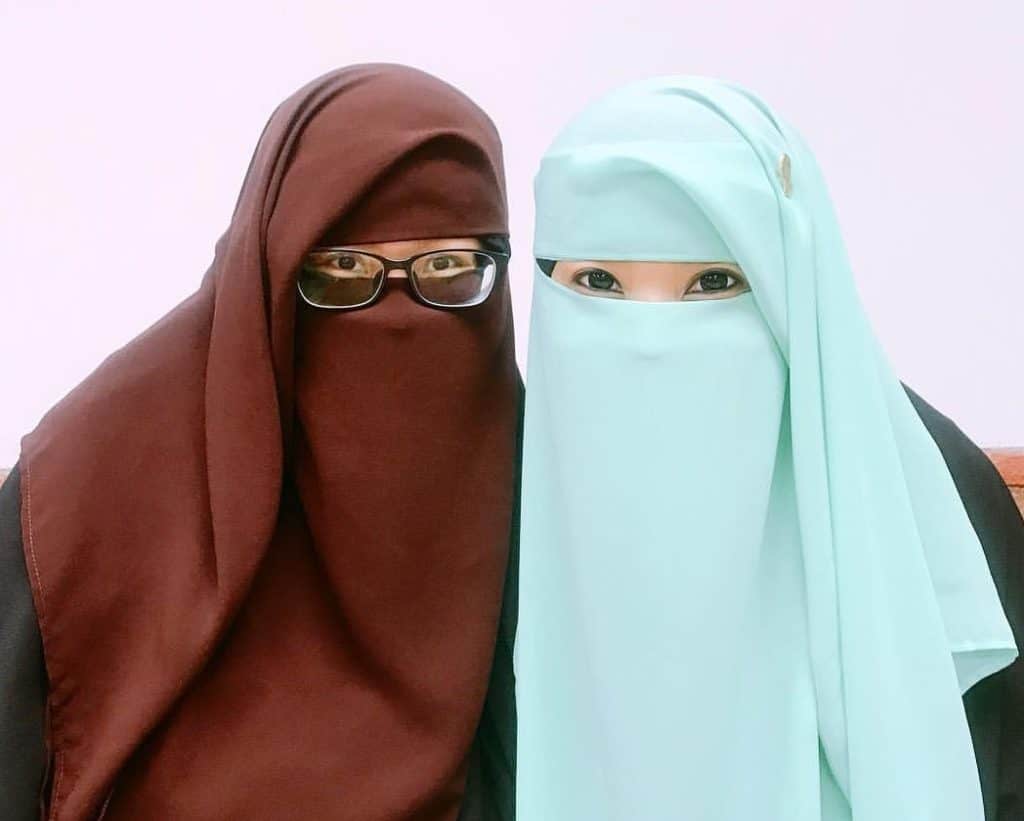
Islamic scholars of the past and present differ on whether the face veil (Niqaab) is an obligatory dress for Muslim women.
The Quranic verse ( An-Nur 24:31 ) requires that women draw the Khimar material over the head and body in the presence of nonrelative males. However, there is always a difference of opinion as to whether this should include the face.
) requires that women draw the Khimar material over the head and body in the presence of nonrelative males. However, there is always a difference of opinion as to whether this should include the face.
The majority of scholars agree that wearing a face veil is not obligatory for Muslim women. However, they all agree that is is better and preferred.
The consensus is that if the wearing of makeup, eye-blackner (Kohl), jewelry, and positioning of the hair is likely to lead to provocation in men, then it becomes obligatory for a Muslim woman to cover her face.
Quranic evidence for covering the face is given in the verse Al Azab 33:59 in which believing women are ordered to bring down over themselves their outer garments.
in which believing women are ordered to bring down over themselves their outer garments.
Allah (SWT) maintains that such an action is more suitable for women, that they will become known and better respected.
To read and understand more about the issue of the face veil (Niqqaab) click to see the Obligatory Conditions For Hijab  and The Rulings About The Islamic Face Veil.
and The Rulings About The Islamic Face Veil.
Conclusion
In the following verse, believing Muslim women are told to wear outer cloaks, which modestly cover the shape of the body. In the Quran, it is explicitly mentioned that the purpose of the Hijab is to signify religion/ piety and to protect women from being abused and harassed by strange men.
“O Prophet, tell your wives and your daughters and the women of the believers to draw their cloaks close round them (when they go abroad). That will be better, so that they may be recognized [as respectable believing women] and not annoyed. Allah is ever Forgiving, Merciful.”
Quran 33:59).
Even those in Muslim-majority nations may be hesitant to accept proper (loose) Hijab or Niqab (the face-veil), especially in the workplace.
However, there are countless instances of Hijabi women in Muslim and non-Muslim countries working as doctors, lawyers, politicians, etc.
So this is an incorrect assumption which only damages the self-esteem of young Muslim women.
On the more conservative side of things, Muslim women who already observe the face-veil (Niqab) might be discouraged from entering the workforce or other activities that would otherwise be permissible (Halal) in Islam.
The purpose of the headscarf (Hijab) or Face-veil (Niqab) should not be an obstacle for pursuing a career or education, rather this is only a burden placed on women from societal expectations.
Related Questions


Does Wearing The Headscarf (Hijab) Serve Any Social Benefits?
There are many benefits of wearing hijab outside of the more obvious spiritual reasons. The headscarf (Hijab) can be a beautiful way to express one’s Muslim, feminine, and cultural identity. Also, there is a growing Hijabi fashion industry.
Written By Aminah Coon & Mohammed Francis
Find Me At:
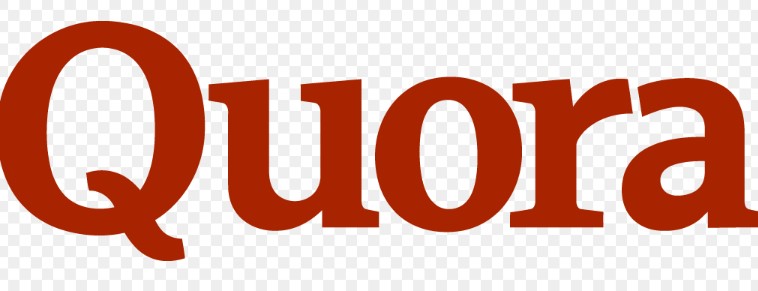
I have been a practicing American Muslim since 2016. I am interested in Islam, world religions, hair care, fitness, food, American and Middle Eastern politics, and language acquisition. Student of Biochemistry & Jilbabi, Niqabi
References And Useful Links
Women-Guard Private Parts Not Expose Adornments -Quran An-Nur 24:31
-Quran An-Nur 24:31
Women-Cover Using Outer Garments -Quran Ahzab 35:59
-Quran Ahzab 35:59
What Is Awrah?-Fiqh Ruling -Islam Q & A
-Islam Q & A
Types of Hijab -Wikipedia
-Wikipedia
Example of Hijab in The Quran -Quran Al Azhab 33:53
-Quran Al Azhab 33:53
The Rulings Concerning The Islamic FaceVeil -The Beauty Of Modesty
-The Beauty Of Modesty
Obligatory Conditions For Hijab -igotitcovered.com
-igotitcovered.com
Women Wrap Outer Garments Around Yourselves -Quran Al-Ahzab 33:59
-Quran Al-Ahzab 33:59
